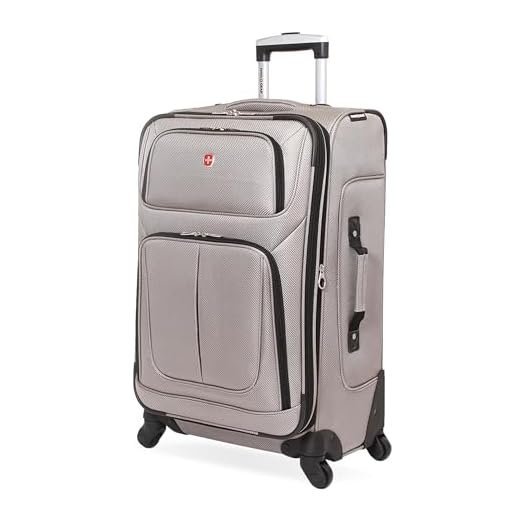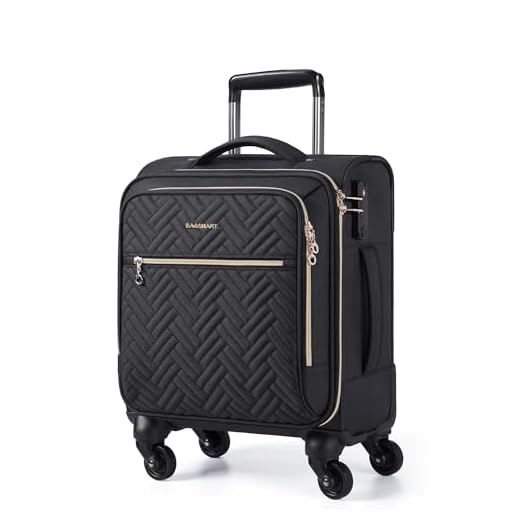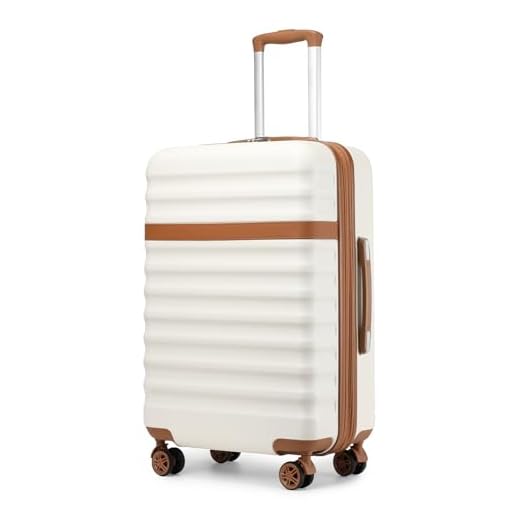







Accurate dimensions are critical when selecting travel carriers. Most retailers adhere to specific guidelines that define height, width, and depth, typically expressed in inches or centimeters. For hard-shell and soft-sided options, pay close attention to whether the measurements include wheels and handles, as these can significantly impact fit within airline restrictions.
Many brands indicate capacity in liters, providing insight into the storage potential. For example, a standard carry-on usually ranges from 40 to 55 liters, making it easier to compare sizes. Gauge your needs by assessing the anticipated length of trips, as this will inform whether a smaller option suffices or if a larger variant is necessary.
Always verify with airline regulations, as they impose specific limitations on size and weight. The three main measurements–length, width, and height–should be thoroughly understood to maximize compliance and convenience during travel. Familiarizing yourself with these specifics will streamline your shopping experience and enhance your travel readiness.
Understanding Standard Luggage Dimensions
For air travel, familiarize yourself with common sizes used in the industry. Typically, manufacturers classify bags as carry-on or checked. Carry-on items usually measure up to 22 x 14 x 9 inches (56 x 36 x 23 cm), while checked varieties often vary, with many falling into a range of 24 to 30 inches (61 to 76 cm) in height.
International travel might impose stricter limits. For instance, airlines in Europe might set maximum dimensions for cabin baggage at 21.5 x 15.5 x 9.5 inches (55 x 40 x 23 cm). Always double-check with your airline, as policies can differ.
Weight is another key factor. Carry-on pieces are generally capped at about 15 to 22 pounds (7 to 10 kg). Checked bags, depending on the airline, can allow up to 50 pounds (23 kg) before incurring additional fees.
Consider volume when selecting a bag. Brands often list capacity in liters, which can help estimate the amount of clothing and items you can pack. A 40-50 liter capacity is generally suitable for a week-long trip.
Pay attention to additional features like wheels and handles, which can affect both size and usability. Expandable options often offer flexibility in packing.
In conclusion, become familiar with specific measurements, weights, and features to ensure compliance with various travel regulations and enhance your packing efficiency.
Methods for Measuring Luggage Size
For accurate assessment of travel bags, utilize both external and internal dimensions. External measurements typically include height, width, and depth, while internal metrics focus on usable space.
- External Dimensions: Measure from the bottom to the top (height), side to side (width), and front to back (depth). Include wheels and handles in these dimensions to ensure compliance with airline standards.
- Internal Capacity: Open the bag, and measure the interior space by height, width, and depth to determine how much can be packed, excluding exterior features.
Employing a soft measuring tape provides flexibility compared to rigid rulers, which can be limiting. Ensure accuracy by measuring in inches or centimeters, as required by retailers or airlines.
Remember to measure each section independently and record the largest dimensions to account for variance in design.
- Place the bag on a flat surface to ensure stability while measuring.
- Use a notebook to document your findings for reference when comparing different styles.
- Check the specifications from manufacturers to confirm your measurements align with any stated dimensions.
Consider the weight of the empty bag as well, as this can impact overall travel convenience and compliance with airline restrictions.
Key Factors Influencing Volume of Travel Bags
Dimensions play a significant role in the capacity of travel containers. Key measurements include height, width, and depth. Typically, the height is the vertical measurement, while width indicates the side-to-side distance, and depth reflects how thick the bag is. Each of these dimensions collectively determines the overall volume.
Material also impacts internal capacity. Soft-sided options usually allow for some flexibility, making it easier to pack items snugly. Contrarily, hard-shell varieties maintain their structure, potentially limiting space depending on their design.
Design elements, such as compartments and pockets, contribute to usability without altering the primary dimensions. For instance, external pockets can provide extra storage without influencing the main volume but may limit the effective packing space inside.
Weight restrictions must be considered as well. Heavier materials might reduce the amount of room available for packing, as travelers need to adhere to airline weight limits. Lightweight options maximize packing space while remaining compliant with transportation regulations.
Overall configuration affects convenience. Rolling bags often provide more accessible packing options than traditional styles, potentially increasing packing ability. Functionality, therefore, plays a crucial role in determining practical volume usage.
Differences in Measurement Criteria by Brand
Different manufacturers employ varying standards in calculating the dimensions of their travel gear. For instance, some brands might include external features such as wheels, handles, and pockets in their size specifications, while others focus solely on the interior capacity. This discrepancy is crucial to consider when making a purchase.
Brands like Samsonite and Tumi are known for their precise sizing, often listing measurements inclusive of every component, while more budget-friendly retailers may provide dimensions that reflect the core structure alone. This can lead to confusion regarding the actual usable space when packing.
Additionally, the way volume is interpreted can differ significantly. Certain manufacturers emphasize cubic inches or liters, which could mislead buyers into thinking they have greater capacity than reality. Brands with a reputation for durability and innovation often advertise more detailed volume metrics, allowing consumers to gauge storage potential more accurately.
Another critical consideration involves the weight of the bags. Some labels may define limits based on the total package weight rather than just the case itself, impacting travel choices significantly. Therefore, it’s wise to consult multiple sources and compare metrics to ensure you select the right item for your needs.
For frequent travelers seeking connectivity and tracking capabilities, exploring accessories like best luggage gps tags can greatly enhance travel experiences, providing peace of mind alongside optimal gear selection.
Regulations for Luggage Size in Airlines
Airlines enforce strict guidelines governing the dimensions and weight allowances for travel bags. Compliance with these regulations is pivotal for a smooth boarding process. Most carriers specify maximum sizes for both checked and carry-on options, which can vary significantly. Always verify the specific airline policies prior to departure.
Common Size Limits
Typically, airlines establish size limits in inches (length + width + height):
| Type | Maximum Dimensions | Weight Limit |
|---|---|---|
| Carry-on | 22 x 14 x 9 | 15-20 lbs |
| Checked | 62 inches total | 50 lbs |
Packing Tips for Compliance
To avoid inconvenience, measure bags accurately before your trip. Consider investing in a luggage scale to ensure compliance with weight restrictions. If possible, pack lighter to enhance convenience and flexibility during travel. This preventative approach minimizes the chance of additional fees or time-consuming airport adjustments.
For those interested in leisure activities while traveling, check out the best aquarium in phoenix, which provides a unique experience during your stay.
Tools and Techniques for Accurate Measurement
Employing precise instruments is crucial for determining bag dimensions. Consider the following tools:
- Measuring Tape: A flexible tape is ideal for capturing length, width, and height.
- Calipers: Useful for getting exact measurements, especially for smaller items or specific features.
- Level Surface: Always measure on a flat area to avoid inaccuracies caused by uneven ground.
Techniques to enhance measurement accuracy include:
- Flat Positioning: Place the item fully open and flat to get the most accurate dimensions.
- Include Wheels and Handles: Ensure that any protruding features are included in your measurements.
- Double Check: Measure multiple times to confirm consistency and accuracy.
Using a digital scale can also aid in determining the weight, which might be relevant for certain sales criteria.
Tips for Specific Shapes
For non-standard or oddly-shaped bags:
- Box Method: For irregular shapes, encase the item in a rectangular box and measure the box dimensions.
- Creating a Template: Use cardboard to create a template for unique designs, aiding in uniform measurement.
By integrating these tools and methods, achieving accurate dimensioning of travel cases becomes streamlined, facilitating better sales processes.
FAQ:
What are the standard measurements used for luggage when sold?
Luggage is typically measured based on its dimensions: length, width, and height. For most retailers, the measurements are given in inches or centimeters. Commonly, carry-on bags should not exceed 22 x 14 x 9 inches (56 x 36 x 23 cm), while larger luggage pieces can range from 24 to 30 inches in height. The weight of the luggage is also a crucial factor, with many companies providing a weight limit, often around 50 pounds (23 kg) for checked luggage.
How do manufacturers ensure that luggage meets size specifications for sale?
Manufacturers conduct rigorous testing and adhere to industry standards to ensure that luggage dimensions comply with specifications. They often utilize precise measurement tools during production to confirm that each piece meets the designated size before it is packaged for sale. Additionally, quality control checks are performed to verify that the finished products maintain consistency with the labeled dimensions.
Are there any regulations regarding luggage size for air travel that consumers should be aware of?
Yes, airlines have specific luggage size regulations that must be followed. Each airline has its own maximum dimensions for both carry-on and checked luggage. For instance, many airlines allow carry-ons up to 22 inches, but some may have different limits. It’s essential for consumers to check the airline’s website before traveling to avoid additional fees or having to check a bag at the gate. Familiarizing themselves with both the airline’s and the manufacturer’s guidelines can help travelers make informed decisions when purchasing luggage.
What factors might influence the price of luggage based on its measurements?
The price of luggage can be influenced by various factors related to its measurements. Larger bags often come with higher prices due to increased materials and design complexity. Additionally, specialized features—such as expansion zippers, durable wheels, and reinforced structures—can impact the cost. The brand reputation and market positioning also play a role; premium brands might charge more for similar sizes due to perceived quality and brand loyalty. Consumers should consider their travel needs and budget when selecting luggage, balancing size with cost and features.








